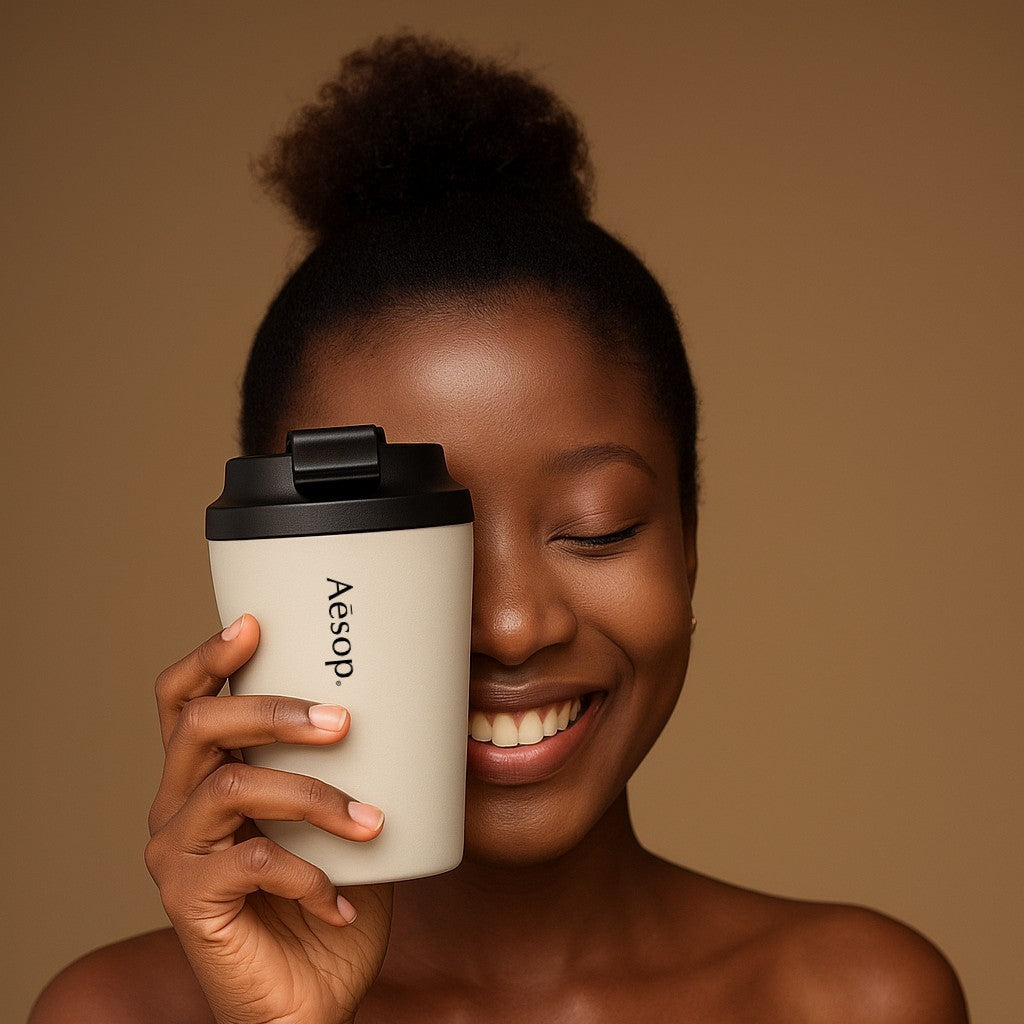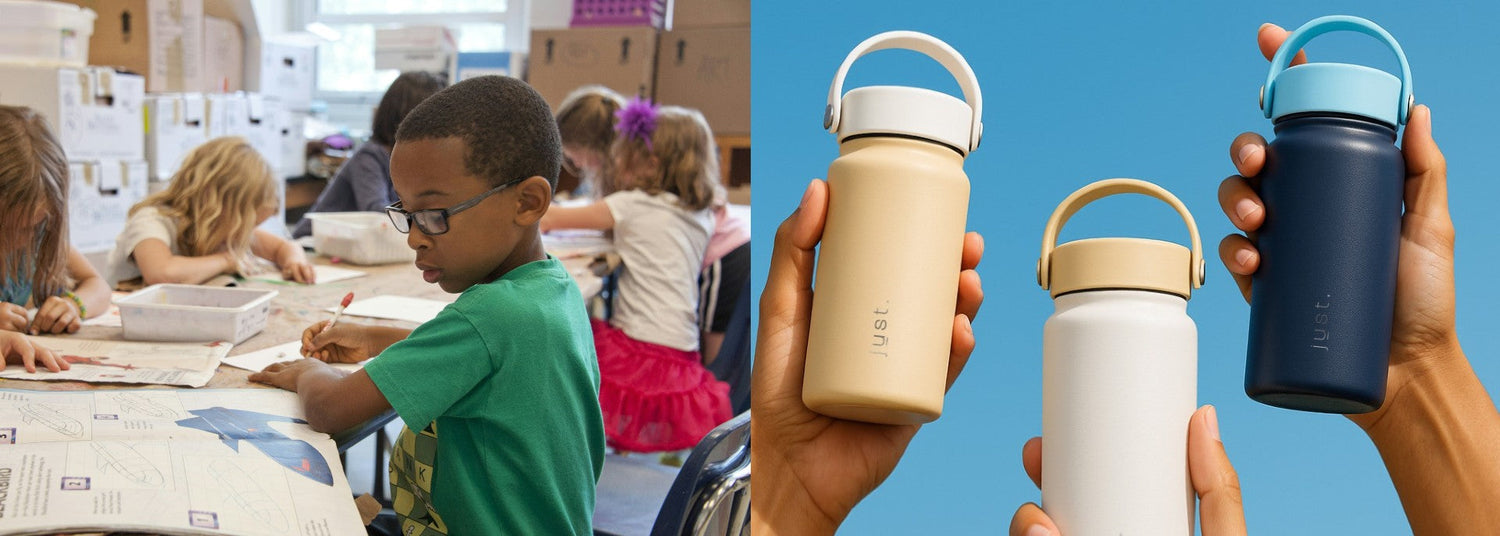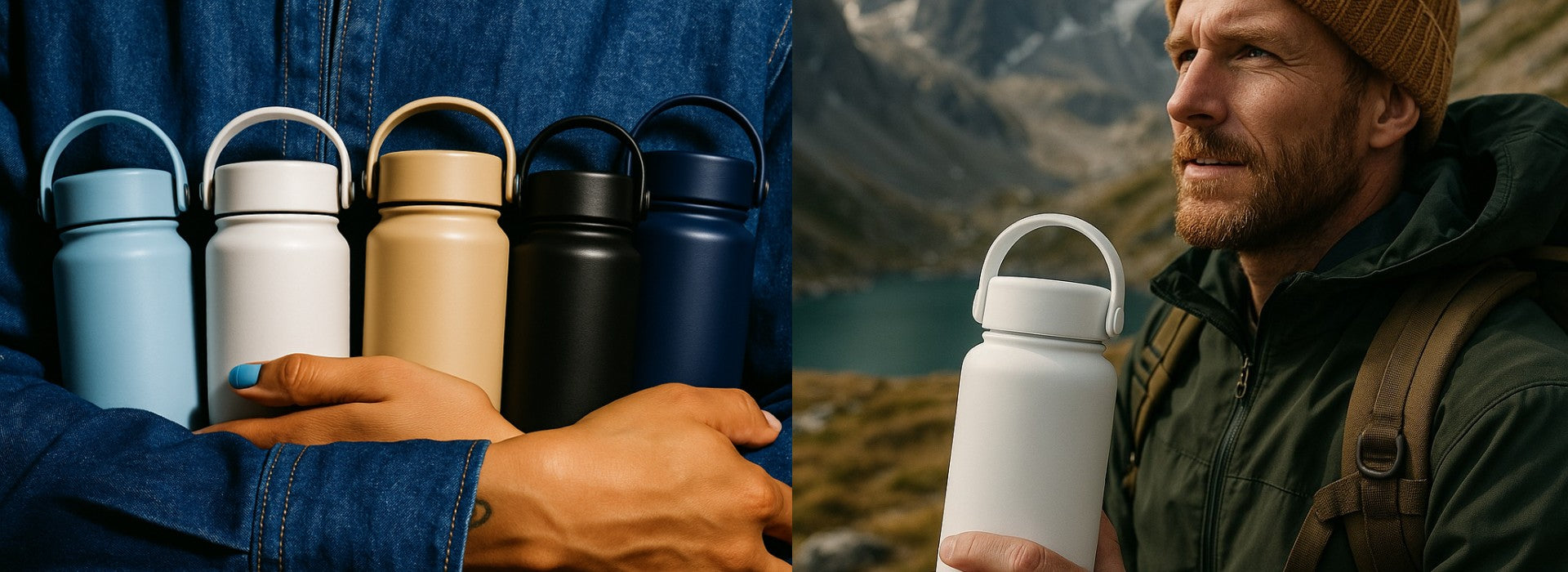As parents, it can be hard to sort through all the advice on what our children need for school. But one essential item that shouldn’t be overlooked is a reusable water bottle.
Not only does it support healthy hydration habits, but the right size bottle can make all the difference in whether your child actually uses it. In this article, we’ll explore what size water bottle is best for school-aged children - and why choosing the right one matters.
Table of contents
What size water bottle is best for school?
Choosing the right water bottle for your child
Benefits of bringing a water bottle to school
Tips to keep kids hydrated at school
So, what size water bottle is best for school?
Choosing the right water bottle size for school depends on your child’s age, daily routine, and activity level. As industry experts in sustainable drinkware, we recommend the following:
For younger students (middle school and below):
A 550ml / 18oz water bottle is the ideal size. It’s lightweight enough for small hands to carry, fits easily in school bags and won’t take up too much space in a crowded backpack.
Choosing a stainless steel, double-wall insulated bottle offers even more benefits. It keeps water cold for hours - encouraging kids to drink more throughout the school day - and is far more durable than plastic alternatives. Plus, stainless steel is naturally BPA-free, stain resistant, and won’t retain flavours, making it a safe and hygienic option for daily use. It’s a bottle that can withstand drops, spills, and everything else a typical school day throws at it.
For older students or active kids:
A larger 1L / 34oz water bottle is ideal for staying properly hydrated throughout the school day, especially for teens, athletes, or students who have limited access to refill stations. Whether they’re heading to PE, after-school sports, or simply have a busy schedule that keeps them on the go, a 1L bottle ensures they have enough water without constantly needing a top-up.
Opting for a stainless steel, double-wall insulated bottle means drinks stay cold and refreshing for hours - perfect for hot classrooms, bus rides, or outdoor activities. These bottles are also incredibly durable, making them a reliable choice for older kids who may carry heavier bags or use the same bottle across school, gym, and home. With its large capacity and long-lasting insulation, a 1L bottle supports healthy hydration habits and reduces reliance on disposable plastic bottles, making it a win for both your child and the planet.
Choosing the right water bottle for your child
Selecting the right bottle isn’t just about capacity - it’s about finding a safe, functional, and appealing option your child will actually enjoy using every day.
Key factors to consider
1. Choose safer materialsWhen it comes to kids’ water bottles, material matters. Stainless steel is a standout choice - it’s naturally BPA-free, resistant to rust and staining, and incredibly durable. Unlike plastic, it doesn’t leach harmful chemicals when exposed to sunlight or heat.
While many plastic bottles are now labeled “BPA-free,” opting for stainless steel gives added peace of mind. Reputable manufacturers like Just Bottle also ensure the lids are made from BPA-free plastic or silicone, making the entire bottle safe for everyday use.
Further reading: The benefits and drawbacks of different water bottle materials
2. Look for double-wall insulationDouble-wall vacuum insulation is a game-changer for school hydration. It keeps drinks cold for hours, even in a hot classroom or during outdoor sports. This means your child always has access to cool, refreshing water, especially important in warmer months or after physical activity.
Only stainless steel bottles offer this level of insulation performance, making them a smart, long-lasting investment.
3. Go for easy-to-use featuresThe design of the bottle should match your child’s age and ability. For younger kids, look for bottles with straw lids or flip-tops - these are easier to use and encourage regular sipping. For older children or teens, a screw-top lid is usually simple enough and may even be preferred.
A wide-mouth opening also makes it easier for kids to refill their bottles at school and simplifies cleaning when they get home (which you’ll thank us for).
In short, the best water bottle for school is one that’s safe, easy to use, keeps drinks cold, and fits into your child’s daily routine without fuss. For most children, we recommend a 550ml/18oz insulated stainless steel bottle as the perfect balance of hydration and portability.
The benefits of bringing a water bottle to school
Hydration is key to maintaining optimal health and well-being, especially for growing children. By having a water bottle readily available throughout the day, students are more likely to meet their daily water intake needs.
If kids can't get water during lessons, they might get dehydrated. Children often choose sugary drinks instead of water between lessons or at lunch. Having their own kids water bottle nearby can help them drink water regularly. This can encourage them to stay hydrated throughout the day.
Dehydration can lead to fatigue, difficulty concentrating, and even headaches, which can hinder a child's ability to learn and perform well in school.
Encouraging regular water intake
Having a water bottle readily available throughout the day makes it easier for children to stay hydrated. With busy schedules and limited access to water fountains during school hours, having their own water bottle ensures that they always have a source of hydration nearby. This can lead to increased water consumption and better overall health.
Furthermore, staying properly hydrated can improve cognitive function and mood, helping students to stay focused and engaged in their studies.
By encouraging regular water intake through the use of a personal water bottle, parents and teachers can support children in reaching their full academic potential.
Further reading: How to get kids to drink more water
Reducing the spread of germs
Shared drinking fountains can be a breeding ground for germs and bacteria, especially in school environments. By providing bottles for kids, you can reduce their exposure to communal sources of water, minimising the risk of getting sick or spreading germs.
In addition to reducing the spread of germs, having a designated water bottle can also promote good hygiene practices.
Children are more likely to wash and refill their own water bottle regularly, instilling a sense of responsibility for their health and well-being, whilst also building sustainable habits.
This simple habit can have long-lasting benefits beyond just hydration, teaching children the importance of self-care and cleanliness.
Building sustainable habits
Encouraging kids to use reusable water bottles at school is a vital step in creating sustainable habits from a young age. By providing children with reusable bottles, we instil in them the value of reducing single-use plastic waste and the importance of environmental conservation.
When kids see their peers and teachers opting for reusable options, it creates a culture of sustainability within the school community. Also, using a reusable water bottle teaches children responsibility and ownership over their environmental impact, as they become actively involved in minimizing waste generation.
This practice also fosters a sense of stewardship towards the planet, as kids begin to understand the consequences of their actions on the environment.
Additionally, incorporating reusable water bottles into school routines promotes awareness about the finite nature of Earth's resources and the need to conserve them for future generations.
As children form the habit of using reusable bottles, they are likely to carry this behaviour into their adulthood, leading to a more sustainable society overall.
Encouraging the use of reusable water bottles at school not only reduces plastic waste but also nurtures a generation of environmentally conscious kids committed to preserving our planet for years to come.
Understanding the importance of hydration for children
When maintaining good health, hydration is key for people of all ages. For children, proper hydration is especially crucial as their bodies are still developing and growing. Water plays a vital role in several aspects of children's health, from digestion to temperature regulation.
Encouraging children to drink an adequate amount of water is essential for their overall well-being. Fruits and veggies like watermelon, cucumbers and celery can help with daily hydration, but the most important factor is of course drinking enough water.
Children may not always realise when they are thirsty. Parents should make sure to give them water frequently. This is especially important during exercise and hot weather, where a reusable bottle that keeps drinks cold is essential.
The role of water in kids health
Water is essential for many bodily functions, including nutrient absorption and the body's waste removal.
It helps maintain a healthy digestive system and supports the growth and repair of cells and tissues in children's bodies.
Additionally, staying hydrated helps prevent constipation, which can be a common issue for young ones.
Proper hydration also aids in the regulation of body temperature, which is particularly important during school sports and outdoor play. This applies in cold weather but more importantly during summer, when it's easy to become dehydrated.
Sweating is the body's natural way of cooling down, and adequate water intake helps replenish the fluids lost through sweat. By ensuring that children drink enough water, parents can help prevent dehydration and heat-related illnesses.
Hydration and cognitive function in kids
Studies have shown that hydration plays a significant role in cognitive function in children. Even mild dehydration can affect their attention span, memory, and overall cognitive performance.
By keeping your child properly hydrated throughout the day, you can help optimise their learning potential and promote better academic achievement.
In addition to water, adding hydrating snacks like yoghurt and smoothies into children's diets can also contribute to their overall fluid intake.
Being mindful of signs of dehydration, such as dark urine or dry lips, can help parents intervene early and ensure that their children remain adequately hydrated for optimal health and well-being.
Common concerns about water bottles in school
Now that we've covered the basics of water bottles for school, it's essential to address some common concerns that parents may have.
Ensuring that your child stays hydrated throughout the school day is crucial for their overall well-being and concentration.
While some parents worry that having a water bottle at school may become a distraction for their child or their classmates, it's important to strike a balance.
Encourage your child to take sips of water during designated break times rather than throughout the lesson. By setting boundaries, you can ensure that the water bottle remains a helpful tool rather than a hindrance.
Moreover, the type of water bottle your child uses can also impact their experience. Opt for a leak-proof and easy-to-open water bottle to prevent any unnecessary disruptions during class time. This way, your child can stay hydrated without causing any distractions.
Managing lost or forgotten water bottles
Losing or forgetting a water bottle can be a common issue for children, leading to potential dehydration throughout the day.
To mitigate this, consider labelling your child's water bottle with their name using a waterproof and durable marker. This simple step can significantly increase the chances of the water bottle being returned if misplaced. Alternatively, stickers can be used to personalise the bottle. This also encourages kids to use the bottle all day, if it's something that's unique to them.
Additionally, it's a good idea to keep a spare water bottle at home or in your child's bag as a backup. This ensures that even if one water bottle goes missing, your child always has access to water, promoting their health and well-being at school.
Tips for Encouraging Kids to Drink More Water
Having a water bottle for school is just one part of promoting healthy hydration habits for your child. Here are a few additional tips to encourage them to drink more water.
Make drinking water fun by adding fruits or herbs to create naturally flavored water. Providing your child with a colorful, fun, or character-themed water bottle can also make the experience more enjoyable. Stickers are a great way of doing this, that way they can choose their own and decorate the bottle how they like.
Additionally, setting a good example by drinking water yourself and offering it as the primary beverage option at home can encourage your child to follow suit. Getting in the habit of drinking water instead of sugary drinks will improve your health, and set a great example for the little ones.
Collaborating with Schools for Hydration Education
Engage with your child's school to promote hydration education. Encourage the implementation of water breaks or the provision of water stations to ensure children have easy access to drinking water throughout the day. By working together, we can create a healthier and more hydrated environment for our children.
In conclusion, while it is not a necessity, providing your child with a water bottle for school comes with numerous benefits. By ensuring they stay hydrated, you are supporting their overall wellbeing, cognitive function, and healthy habits. So why not equip your child with their own water bottle and help them sip their way to a healthier future?
FAQ's
What size water bottle is best for primary school children?
A 550ml (18oz) insulated stainless steel bottle is ideal for younger children. It’s lightweight, fits easily in backpacks, and keeps water cold throughout the day.
Can my child bring a water bottle to school?
Yes – most schools encourage students to bring reusable water bottles to stay hydrated. Make sure it’s labelled and leak-proof to avoid spills in school bags.
How can I encourage my child to drink more water during the school day?
Choose a fun, easy-to-use bottle with features like a straw lid or custom stickers. You can also flavour the water naturally with fruit to make it more appealing.
What’s the safest material for kids’ water bottles?
Stainless steel is widely considered the safest option. It’s BPA-free, durable, and keeps drinks at the right temperature. Avoid low-quality plastic bottles or aluminium bottles that may leach chemicals.





